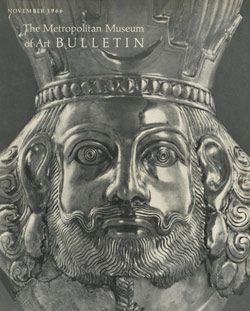Vessel in form of female (?) figure
Not on view
This vessel in the form of a human figure survives only in a handful of pieces, comprising parts of the head, face, neck, chest and both shoulders and elbows. It was restored based on another vessel found with it, which, although fragmentary, preserves the entire height of the figure. It is made of a red clay; most of the vessel is handmade, while the figure’s hat appears to have been made on a wheel.
In its restored form the vessel is roughly cylindrical with a flat base and a slightly flaring rim at the top that also serves as the figure’s pillbox hat. The figure has a globular head and a thick neck with a pointed chin or beard at the front. The mouth is indicated by a horizontal slit, and the eyes are incised circles carved into large depressions. The figure has a prominent nose and flat ears. It holds its slender arms at its sides with elbows bent and hands clasped at its stomach. Two nipples are represented by large raised dots. The figure wears a necklace with a pyramidal pendant, possibly meant to be a stamp seal.
The remains of this vessel were excavated in 1935 at Chekka Sabz (also spelled Chigha Sabz, meaning ‘green mound’) in the Pish-i Kuh (‘before the mountain’) region of Luristan in western Iran. These remains were found in a buried cache of objects which included two Neo-Elamite cylinder seals, at least four bull-shaped jugs, and the other vessel in the form of a human figure. The seals date to the 8th-6th centuries B.C., and the pottery found with them, including this vessel, likely date to the same period. Although probably a small village in the Bronze Age, by the Iron Age Chekka Sabz had been reduced to a campsite, perhaps used by pastoralists as they transitioned between summer and winter pastures. The cache seems to have been buried in haste, and it is clear that whoever buried the objects did not, or could not, return to recover them.
The gender of the figure is unclear. The large nipples and clean shaven chin suggest a female. However, the figure found with this one at Chekka Sabz has been interpreted as male, on the grounds that the chin is in fact a pointed beard. There are no other features that compel one identification or the other. The figure’s posture, with the hands clasped at the stomach, is echoed in Elamite art, where it appears to be the proper gesture to make in the presence of a god. The people at Chekka Sabz were clearly familiar with Elamite material culture, and it stands to reason that the gesture indicates that this figure represents an attentive worshipper. As such, the vessel may have been intended to serve as an offering to a god. The bull-shaped vessels found with it may well have served a similar purpose.
This image cannot be enlarged, viewed at full screen, or downloaded.





